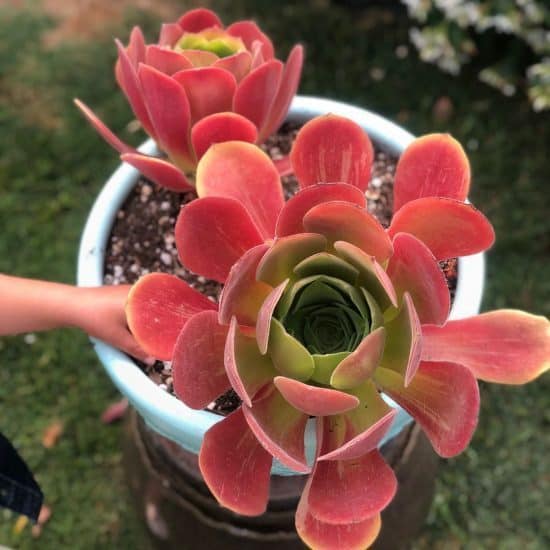How to Change the Color of Succulents
To alter the color of the succulents, we must replicate their natural environment. This tends to work with desert succulents. We need to subject them to extreme conditions such as:
How would you characterize the soil in the desert?
The only requirement for soil for succulents is that it drains well. Some plants don’t mind if the soil is fertile or not. The general potting soil is not ideal for succulents because it retains a lot of water. Making your own soil mixture or purchasing one designed for cacti and succulents is preferable.
Is it constantly raining in the desert? Nope.
Resist the urge of watering the succulents too much. These plants can stay in completely dry soil for weeks.
Rain rarely falls and only lasts a short time in the desert. Due to the intense heat, succulents quickly absorb water before it evaporates. Water your succulents less frequently if you want them to change color. But when you water, water them thoroughly.
Until the water empties from the drainage hole, water them. Water them several times in a row if the substrate dries out too quickly to ensure that the roots take up the water.
The succulents’ color can be altered by increasing the amount of light they receive. However, this does not imply that you should expose them to direct sunlight right away.
Despite growing in full sun in the desert, succulent plants typically grow next to rocks or under taller cacti. So they can enjoy some shade during the day.
Gradually increase the exposure of your plants to the sun. The succulents will produce more carotenoids as a result, shielding the plant from sun damage.
Invest in a good grow light that is bright enough to replace the natural sun to increase the lighting for succulents grown indoors. See our recommendations on LED grow light strips here.
Succulents protect themselves from high and low temperatures. The succulent plants’ leaves close during the summer to prevent evaporation. However, some people also do this in the winter to protect themselves from the cold.
In both cases the succulents get stressed and change color.
Do not fertilize when you stress your succulents. If you do, they will temporarily turn back to their original color.
Why Do Succulent Leaves Turn Red?
Succulents have a color-changing trait that is brought on by environmental changes. When under stress from excessive sunlight, high or low temperatures, drought, and other factors, succulent leaves turn red. These succulents’ change in color isn’t just for show; it’s also an adaptive response, which means they’re adjusting to prevent long-term damage from the constant stress placed on them.
The succulents absorb water and carbon dioxide by photosynthesis. Then, they convert it into oxygen and glucose. The pigments used in this process called:
Since chlorophyll is in charge of absorbing sunlight to maintain the cycle of photosynthesis, most succulent plants in the shade are green.
When succulents are exposed to the sun or high temperatures, more carotenoids are found in the plant’s cells. These shield succulents from excessive UV light exposure and high temperatures.
On the other hand, anthocyanins are more stable at lower temperatures. This explains why we frequently see vibrant colors in the fall and winter and succulent greens in the summer.
Stressing succulents is the process of causing them to change color.

Move Your Succulent Plants Inside at Night for a Few Weeks During Cold Seasons
When succulent leaves are exposed to cold temperatures, they will turn red, which may result in succulent death.
Succulents may start to turn red if the temperature falls below 50 degrees Fahrenheit because the cells are stressed.
However, if you bring succulents inside during the colder months, they will be able to use less energy and store more water, which will prevent them from turning red.
